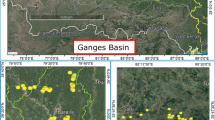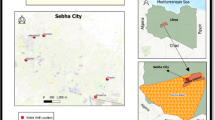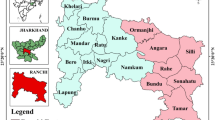Abstract
The continuous deterioration of drinking water quality supplies by several anthropogenic activities is a serious global challenge in recent times. In this current study, the drinking water quality of Ikem rural agricultural area (southeastern Nigeria) was assessed using chemometrics and multiple indexical methods. Twenty-five groundwater samples were collected from hand-dug wells and analyzed for physicochemical parameters such as pH, major ions, and heavy metals. The pH of the samples (which ranged between 5.2 and 6.7) indicated that waters were slightly acidic. Cations and anions (except for phosphate) were within their respective standard limits. Except for Mn, heavy metals were also found to be below their maximum allowable limits. Factor analysis identified both geogenic processes and anthropogenic inputs as possible origins of the analyzed physicochemical parameters. Modified heavy metal index, geoaccumulation index, and overall index of pollution revealed that all the hand-dug wells were in excellent condition, and hence safe for drinking purposes. However, pollution load index, water quality index (WQI), and entropy-weighted water quality index (EWQI) revealed that some wells (about 8–12%) were slightly contaminated, and hence are placed in good water category. A hierarchical cluster analysis (HCA) was performed based on the integration of the WQI and EWQI results. The HCA revealed two major quality categories of the samples. While the first cluster comprises of samples classified as excellent drinking water by both WQI and EWQI models, the second cluster comprises of about 12% samples which were identified as good water by either the WQI or EWQI.




Similar content being viewed by others
Explore related subjects
Discover the latest articles and news from researchers in related subjects, suggested using machine learning.References
Adimalla, N., & Wang, H. (2018). Distribution, contamination, and health risk assessment of heavy metals in surface soils from northern Telangana, India. Arabian Journal of Geosciences, 11, 684. https://doi.org/10.1007/s12517-018-4028-y.
Adimalla, N., Qian, H., & Wang, H. (2019). Assessment of heavy metal (HM) contamination in agricultural soil lands in northern Telangana, India: an approach of spatial distribution and multivariate statistical analysis. Environmental Monitoring and Assessment, 191, 246. https://doi.org/10.1007/s10661-019-7408-1.
Amiri, V., Rezaei, M., & Sohrabi, N. (2014). Groundwater quality assessment using entropy weighted water quality index (EWQI) in Lenjanat, Iran. Environment and Earth Science, 72(9), 3479–3490.
Anim-Gyampo, M., Anornu, G., Agodzo, S., & Appiah-Adjei, E. (2019a). Groundwater risk assessment of shallow aquifers within the Atankwidi Basin of Northeastern Ghana. Earth Systems and Environment, 3(1), 59–72.
Anim-Gyampo, M., Anornu, G., Appiah-Adjei, E., & Agodzo, S. (2019b). Quality and health risk assessment of shallow groundwater aquifers within the Atankwidi basin of Ghana. Groundwater for Sustainable Development, 9, 100217.
Anim-Gyampo M, Anornu GK, Agodzo SK, Appiah-Adjei EK (2019c) Groundwater risk assessment for shallow aquifers within the Atankwidi Basin of (Ghana). Advances in sustainable and environmental hydrology, hydrogeology, hydrochemistry and water resources. Springer, pp. 283-286.
APHA. (2005). Standard methods for the examination of water and wastewater (21st ed.). Washington DC: American Public Health Association.
Ashraf I, Khan T, Rashid N, Ramzan S, Khurshid N (2019) Role of some emerging agro-chemicals in groundwater contamination. In: Contaminants in agriculture and environment: health risk and remediation. Agro Environ Media, 1:9–20.
Ayandiran, T., Fawole, O., & Dahunsi, S. (2018). Water quality assessment of bitumen polluted Oluwa river, South-Western Nigeria. Water Resources and Industry, 19, 13–24.
Barba, C., Folch, A., Sanchez-Vila, X., Martínez-Alonso, M., & Gaju, N. (2019). Are dominant microbial sub-surface communities affected by water quality and soil characteristics? Journal of Environmental Management, 237, 332–343.
Bhallamudi, S. M., Kaviyarasan, R., Abilarasu, A., & Philip, L. (2019). Nexus between sanitation and groundwater quality: case study from a hard rock region in India. Journal of Water, Sanitation and Hygiene for Development, 1–11.
Bhutiani, R., Kulkarni, D. B., Khanna, D. R., & Gautam, A. (2017). Geochemical distribution and environmental risk assessment of heavy metals in groundwater of an industrial area and its surroundings, Haridwar, India. Energy, Ecology and Environment, 2(2), 155–167. https://doi.org/10.1007/s40974-016-0019-6.
Conant Jr., B., Robinson, C. E., Hinton, M. J., & Russell, H. A. (2019). A framework for conceptualizing groundwater-surface water interactions and identifying potential impacts on water quality, water quantity, and ecosystems. Journal of Hydrology, 574, 609–627.
Cotruvo, J. A. (2017). 2017 WHO guidelines for drinking water quality: first addendum to the fourth edition. Journal-American Water Works Association, 109(7), 44–51.
da Silva, D. P., Pitaluga, D. P., Scalize, P. S., & Santos, H. O. (2019). Seasonal evaluation of surface water quality at the Tamanduá stream watershed (Aparecida de Goiânia, Goiás, Brazil) using the water quality index. Open Engineering, 9(1), 90–98.
Dash, S., Borah, S. S., & Kalamdhad, A. (2019). A modified indexing approach for assessment of heavy metal contamination in Deepor Beel, India. Ecological Indicators, 106, 105444. https://doi.org/10.1016/j.ecolind.2019.105444.
Egbueri, J. C. (2018). Assessment of the quality of groundwaters proximal to dumpsites in Awka and Nnewi metropolises: a comparative approach. International Journal of Energy and Water Resources, 2, 33–48. https://doi.org/10.1007/s42108-018-0004-1.
Egbueri, J. C. (2019a). Water quality appraisal of selected farm provinces using integrated hydrogeochemical, multivariate statistical, and microbiological technique. Modeling Earth Systems and Environment, 5(3), 997–1013. https://doi.org/10.1007/s40808-019-00585-z.
Egbueri, J. C. (2019b). Evaluation and characterization of the groundwater quality and hydrogeochemistry of Ogbaru farming district in southeastern Nigeria. SN Applied Sciences, 1. https://doi.org/10.1007/s42452-019-0853-1.
Egbueri, J. C. (2019c). Groundwater quality assessment using pollution index of groundwater (PIG), ecological risk index (ERI) and hierarchical cluster analysis (HCA): a case study. Groundwater for Sustainable Development, 10, 100292. https://doi.org/10.1016/j.gsd.2019.100292.
Egbueri, J. C. (2020). Heavy metals pollution source identification and probabilistic health risk assessment of shallow groundwater in Onitsha, Nigeria. Analytical Letters, 1–19. https://doi.org/10.1080/00032719.2020.1712606.
Egbueri, J. C., & Unigwe, C. O. (2019). An integrated indexical investigation of selected heavy metals in drinking water resources from a coastal plain aquifer in Nigeria. SN Applied Sciences, 1. https://doi.org/10.1007/s42452-019-1489-x.
Egbueri, J. C., & Unigwe, C. O. (2020). Understanding the extent of heavy metal pollution in drinking water supplies from Umunya, Nigeria: an indexical and statistical assessment. Analytical Letters, 1–23. https://doi.org/10.1080/00032719.2020.1731521.
Egbueri, J. C., Mgbenu, C. N., & Chukwu, C. N. (2019). Investigating the hydrogeochemical processes and quality of water resources in Ojoto and environs using integrated classical methods. Modeling Earth Systems and Environment. https://doi.org/10.1007/s40808-019-00613-y.
Ezenwaji, E., & Ezenweani, I. (2019). Spatial analysis of groundwater quality in Warri Urban, Nigeria. Sustainable Water Resources Management, 5(2), 873–882.
Feng, Y., Fanghui, Y., & Li, C. (2019). Improved entropy weighting model in water quality evaluation. Water Resources Management, 33(6), 2049–2056.
Florea L (2019) Evaluation of Karst aquifer water quality associated with agricultural land use. Karst Water Environment. Springer, pp. 157-190.
Gao S, Li W, Zhang B, Zhang C, Li Y (2019) Laboratory steady-state flow test of square infiltration recharge well with filter layer. In: 2018 7th International Conference on Sustainable Energy and Environment Engineering (ICSEEE 2018): Atlantis Press.
Ghaderpoori, M. (2018). Heavy metals analysis and quality assessment in drinking water–Khorramabad city, Iran. Data in Brief, 16, 685–692.
Gorgij, A. D., Kisi, O., Moghaddam, A. A., & Taghipour, A. (2017). Groundwater quality ranking for drinking purposes, using the entropy method and the spatial autocorrelation index. Environment and Earth Science, 76(7), 269.
Hamuna, B., Tanjung, R. H. R., & Alianto, A. (2019). Assessment of water quality and pollution index in coastal waters of Mimika, Indonesia. Journal of Ecological Engineering, 20(2), 87–94.
Jebreen, H., Wohnlich, S., Banning, A., Wisotzky, F., Niedermayr, A., & Ghanem, M. (2018). Recharge, geochemical processes and water quality in karst aquifers: Central West Bank, Palestine. Environment and Earth Science, 77(6), 261.
Kozak, C., Fernandes, C. V. S., Braga, S. M., Do Prado, L. L., Froehner, S., & Hilgert, S. (2019). Water quality dynamic during rainfall episodes: integrated approach to assess diffuse pollution using automatic sampling. Environmental Monitoring and Assessment, 191(6), 402.
Li, P., & Wu, J. (2019). Drinking water quality and public health. Expo Health, 11(2), 73–79. https://doi.org/10.1007/s12403-019-00299-8.
Li, P., Qian, H., & Wu, J. (2010). Groundwater quality assessment based on improved water quality index in Pengyang County, Ningxia, North west China. Journal of Chemistry, 7, 209–216.
Lintern, A., Webb, J., Ryu, D., Liu, S., Waters, D., Leahy, P., Bende-Michl, U., & Western, A. (2018). What are the key catchment characteristics affecting spatial differences in riverine water quality? Water Resources Research, 54(10), 7252–7272.
Luo, Y., Atashgahi, S., Rijnaarts, H. H., Comans, R. N., & Sutton, N. B. (2019). Influence of different redox conditions and dissolved organic matter on pesticide biodegradation in simulated groundwater systems. Science of the Total Environment, 677, 692–699.
Malan, A., & Sharma, H. R. (2018). Groundwater quality in open-defecation-free villages (NIRMAL grams) of Kurukshetra district, Haryana, India. Environmental Monitoring and Assessment, 190(8), 472.
Mgbenu, C. N., & Egbueri, J. C. (2019). The hydrogeochemical signatures, quality indices and health risk assess-ment of water resources in Umunya district, southeast Nigeria. Applied Water Science, 9(1), 22. https://doi.org/10.1007/s13201-019-0900-5.
Mistry, C., Sharma, N., & Trivedi, M. (2019). Assessment of ground water quality in and around lignite mine of Rajpardi, Bharcuh, Gujarat (pp. 130–140). Bioinformatics, Pharmaceuticals and Chemical Sciences: Research Journal of Life Sciences.
Mohammadi, A. M., Vafakhah, M., & Javadi, M. R. (2019). The relationship between surface water quality and watershed characteristics. Journal of Civil Engineering and Construction, 8(3), 107–111.
Motew, M., Chen, X., Carpenter, S. R., Booth, E. G., Seifert, J., Qiu, J., Loheide Ii, S. P., Turner, M. G., Zipper, S. C., & Kucharik, C. J. (2019). Comparing the effects of climate and land use on surface water quality using future watershed scenarios. Science of the Total Environment, 1–14.
Mukate, S., Panaskar, D., Wagh, V., Muley, A., Jangam, C., & Pawar, R. (2018). Impact of anthropogenic inputs on water quality in Chincholi industrial area of Solapur, Maharashtra, India. Groundwater for Sustainable Development, 7, 359–371.
Müller, G. (1969). Index of geoaccumulation in sediments of the Rhine River. Geojournal, 2, 108–118.
NIS. (2007). Nigerian standard for drinking water quality. Nigerian Industrial Standard, 554, 13–14.
NPC (National Population Commission) (2006) Population figures. Enugu NPC.
Nwajide, C. S. (2013). Geology of Nigeria’s sedimentary basins. Lagos: CSS Press.
Onwuka, S. O., & Ezugwu, C. K. (2019). Multivariate statistical assessment and spatial distribution of groundwater contamination in Neke and its environs, South-Eastern Nigeria. International Journal of Physical Sciences, 14(8), 62–80.
Onwuka, O. S., Ezugwu, C. K., & Ifediegwu, S. I. (2018). Assessment of the impact of onsite sanitary sewage system and agricultural wastes on groundwater quality in Ikem and its environs, south-eastern Nigeria. Geology, Ecology and Landscapes, 3, 65–81. https://doi.org/10.1080/24749508.2018.1493635.
Radfard, M., Yunesian, M., Nabizadeh, R., Biglari, H., Nazmara, S., Hadi, M., Yousefi, N., Yousefi, M., Abbasnia, A., & Mahvi, A. H. (2019). Drinking water quality and arsenic health risk assessment in Sistan and Baluchestan, Southeastern Province, Iran. Human and Ecological Risk Assessment: An International Journal, 25(4), 949–965.
Rahman, M. A., Kumar, S., Mohana, A. A., Islam, R., Hashem, M. A., & Chuanxiu, L. (2019). Coliform bacteria and trace metals in drinking water, southwest Bangladesh: multivariate and human health risk assessment. International Journal of Environmental Research. https://doi.org/10.1007/s41742-019-00184-x.
Rakotondrabe, F., Ngoupayou, J. R. N., Mfonka, Z., Rasolomanana, E. H., Abolo, A. J. N., & Ako, A. A. (2018). Water quality assessment in the Bétaré-Oya gold mining area (East-Cameroon): multivariate statistical analysis approach. Science of the Total Environment, 610, 831–844.
Rawat, K., Pradhan, S., Tripathi, V., Jeyakumar, L., & Singh, S. K. (2019). Statistical approach to evaluate ground-water contamination for drinking and irrigation suitability. Groundwater for Sustainable Development. https://doi.org/10.1016/j.gsd.2019.100251.
Sargaonkar, A., & Deshpande, V. (2003). Development of an overall index of pollution for surface water based on a general classification scheme in Indian context. Environmental Monitoring and Assessment, 89, 43–67.
Simonyan, G. S., Simonyan, A. G., & Pirumyan, G. P. (2018). Systemic-entropy approach for estimating the water quality of a river. Oxidation Communications, 41(2), 307–317.
Singh, K. R., Dutta, R., Kalamdhad, A. S., & Kumar, B. (2019). Information entropy as a tool in surface water quality assessment. Environment and Earth Science, 78(1), 15.
Song, F., Wu, F., Feng, W., Liu, S., He, J., Li, T., Zhang, J., Wu, A., Amarasiriwardena, D., & Xing, B. (2019). Depth-dependent variations of dissolved organic matter composition and humification in a plateau lake using fluorescence spectroscopy. Chemosphere, 225, 507–516.
Spurr, L. P., Watts, M. P., Gan, H. M., & Moreau, J. W. (2019). Biodegradation of thiocyanate by a native groundwater microbial consortium. PeerJ, 7, 6498.
Subba Rao, N. (2018). Groundwater quality from a part of Prakasam district, Andhra Pradesh, India. Applied Water Science, 8(1), 30.
Tian, R., & Wu, J. (2019). Groundwater quality appraisal by improved set pair analysis with game theory weightage and health risk estimation of contaminants for Xuecha drinking water source in a loess area in Northwest China. Human and Ecological Risk Assessment, 25, 132–157. https://doi.org/10.1080/10807039.2019.1573035.
Ukah, B. U., Egbueri, J. C., Unigwe, C. O., & Ubido, O. E. (2019). Extent of heavy metals pollution and health risk assessment of groundwater in a densely populated industrial area, Lagos, Nigeria. International Journal of Energy and Water Resources, 3, 291–303. https://doi.org/10.1007/s42108-019-00039-3.
Ukah, B. U., Ameh, P. D., Egbueri, J. C., Unigwe, C. O., & Ubido, O. E. (2020). Impact of effluent-derived heavy metals on the groundwater quality in Ajao industrial area, Nigeria: an assessment using entropy water quality index (EWQI). International Journal of Energy and Water Resources. https://doi.org/10.1007/s42108-020-00058-5.
UNESCO (2007) Water Portal Newsletter No. 161: Water-related diseases. https://www.unesco.org/water/news/newsletter/161.shtml. Accessed 12th August 2019.
Ur Rehman, S., Hussain, Z., Zafar, S., Ullah, H., Badshah, S., Ahmad, S. S., & Saleem, J. (2018). Assessment of ground water quality of Dera Ismail Khan, Pakistan, using multivariate statistical approach. Science, 37(4), 173–183.
Wang, D., Wu, J., Wang, Y., & Ji, Y. (2019). Finding high-quality groundwater resources to reduce the hydatidosis incidence in the Shiqu County of Sichuan Province, China: analysis, assessment, and management. Exposure and Health. https://doi.org/10.1007/s12403-019-00314-y.
WHO. (2017). Guidelines for drinking water quality (3rd ed.). Geneva: World Health Organization.
Wu, J., Li, P., & Qian, H. (2011). Groundwater quality in Jingyuan County, a semi-humid area in Northwest China. Journal of Chemistry, 8(2), 787–793.
You, Q., Fang, N., Liu, L., Yang, W., Zhang, L., & Wang, Y. (2019). Effects of land use, topography, climate and socio-economic factors on geographical variation pattern of inland surface water quality in China. PLoS One, 14(6), 0217840.
Author information
Authors and Affiliations
Corresponding author
Ethics declarations
Conflict of interest
The authors declare that they have no conflict of interest.
Additional information
Publisher’s note
Springer Nature remains neutral with regard to jurisdictional claims in published maps and institutional affiliations.
Highlights
• Rural water supply in the study area currently does not face serious pollution threats.
• Factor analysis successfully identified the possible sources of the physicochemical parameters.
• Heavy metal index was modified and successfully used in the water quality assessment.
• The indexical methods used in this study proved to be efficient in water quality assessment.
• Hierarchical cluster analysis identified the wells that have slight pollution imprints.
Rights and permissions
About this article
Cite this article
Egbueri, J.C., Ezugwu, C.K., Ameh, P.D. et al. Appraising drinking water quality in Ikem rural area (Nigeria) based on chemometrics and multiple indexical methods. Environ Monit Assess 192, 308 (2020). https://doi.org/10.1007/s10661-020-08277-3
Received:
Accepted:
Published:
DOI: https://doi.org/10.1007/s10661-020-08277-3




